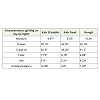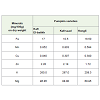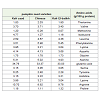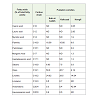Research Article
Studies on Chemical Composition of Some Egyptian and Chinese pumpkin (Cucurbita maxima) Seed Varieties
Al-Anoos IM1*, RAH El-dengawy, and HA Hasanin2
1Food industries Department, Faculty of Agriculture, Damietta University, Damietta, Egypt
2Food Technology Research Institute, Agriculture Research Center, Giza, Egypt
Corresponding author: Al-Anoos, Food industries Department, Faculty of Agriculture, Damietta University, Damietta,Egypt; E-mail: sahl2020@yahoo.com
Citation: Al-Anoos IM, El-dengawi R, Hasanin HA. Studies on Chemical Composition of Some Egyptian and Chinese pumpkin (Cucurbita maxima) Seed Varieties. J Plant Sci Res. 2015;2(2): 137.
Copyright © 2015 Al-Anoos IM, et al. This is an open access article distributed under the Creative Commons Attribution License, which permits unrestricted use, distribution, and reproduction in any medium, provided the original work is properly cited.
Journal of Plant Science & Research | ISSN: 2349-2805 | Volume: 2, Issue: 2
Submission: 06/10/2015; Accepted: 12/11/2015; Published: 18/11/2015
Abstract
The chemical composition of seeds of three pumpkin varieties (Cucurbita maxima)kafr el-batikh, kafrsaadof Egyptian origin and a ChineseHongli varietywere studied for the contents of moisture,crude fiber, proteins, oils, carbohydrates and ashon dry weight basis.Studies were also carried out on aminoacid profile, fatty acids and minerals contents. The results of chemical composition indicate that moisture percentage in these varieties ranged between3.38 to 5.53%, and contains crude fiber (4.124.69%),total lipids(35.2-41.95%), crude protein (34.19- 39.75%), total carbohydrate (4.8-10.96%) and ash(4.22-5.3%). Amino acid analysis revealed that seeds of these varieties have higher level of Glutamic Acid ranging from 33.03 to 34.76g/100g protein. Thefatty acid composition of the oils indicated the predominance of oleic fatty acid (50.0%) in kafr el-batikh oil. Both the Egyptian varieties were prominent inlinoleic (24.82 and 29.5%), palmitic (16.56 and 15.60%) and stearic acid (6.93and 7.50%) contents while Hongli variety was predominant inarachidonicfattyacid(42.94%). The seeds of these varieties contained variable amounts of minerals elements (mg/100g dry weight basis) such as potassium (260,208.3and267), magnesium (96.85,60.95 and 88), manganese (0.852, 0.594 and 0.803), zinc (2.20,1.72 and 2.18), iron (17.0,18.5 and 10.5), copper (0.49, 0.39and 0.397) respectively indicating the mineral richness in kafr el-batikh.
Keywords: Cucurbita maxima; Pumpkin; Chemical composition; Fatty acid; Amino acid; Minerals
Introduction
Pumpkins belong to genus Cucurbita (family Cucurbitaceae)are grown throughout the tropical and sub-tropical countries [1].Worldwide three common types of pumpkin are grown namely C.pepo, C. maxima and C moschata [2]. Five major pumpkin producingcountries in the world are China, India, Ukraine, Egypt and theUnited States [3]. The yellow-orange characteristic color of pumpkinis due to the presence of carotenoids. Pumpkins are a valuable sourceof carotenoids and ascorbic acid, both of which play a major role in nutrition as provitamin A and as an antioxidant respectively [1]. Inaddition, pumpkins are a source of minerals, vitamins, pectin, anddietary fiber. C. moschata has a high amount of pectin, carotene,vitamins, minerals and other elements beneficial to human health[4]. Squash is cultivated throughout the world for use as a vegetableas well as traditionally as medicine in many countries such asChina, Yugoslavia, Argentina, India, Mexico, Brazil and, America.Consumption of foods containing carotene helps prevent skindiseases, eye disorders and cancer [5]. Pumpkin seeds are popular intreating worms and parasites as well as in diabetic treatment [6].
Materials and Methods
Three types of pumpkin seed varieties (5 kg for each variety) werestudied, two of which were planted in Egypt (kafr saad and kafr elbatikh),and the third Chinese variety namly Hongli was planted inChina. Chinese variety was obtained from the local market in Cairowhereas kafr saad and kafr el-batikh were obtained from their regions.The seeds were cleaned from foreign materials, hand dehulled and theobtained kernels were ground by using electrical grinder and used foranalysis. All reagents were purchased from Sigma-Aldrich.
Analytical Method
Gross chemical composition: Moisture content, crude protein(% N x 6.25), crude fat, crude fiber and ash were determined inpumpkin seed samples as well as pumpkin seed flour according to[7] standard method. Carbohydrate content was determined by thedifference.
Determination of minerals
Determination of minerals was carried out by a Flame Photometer410, spekol 11 spectrophotometer and Atomic AbsorptionSpectrophotometer at Agriculture Research Center, Giza, Cairo, asdescribed in [7].
Amino acid composition
Amino acids were determined according to the method describedby [8] with modifications, summarized as follows: 200 mg of dried,defatted sample was hydrolyzed with 5 ml of 6 N HCl, in sealed tubeat 110 °C for 24 hour and the hydrolysate was filtered. The residuewas washed with distilled water and the filtrate was evaporated onwater bath at 50 °C. The residue was dissolved in 5 ml/loading buffer(0. 2N sodium citrate buffer of pH 2.2). Amino acids were determinedchromatographically using Beckmen Amino Acid Analyzer Model119 CL, at Central Lab., at National Research Center, Giza, Cairo.
Fatty acid composition
Fatty acid content of oil samples was determined according tothe method described by [9] and the fatty acid methyl esters (FAME)were analyzed by gas chromatography (Varian 3600 GC, Mississauga,ON). The system was equipped with an auto sampler (Model 8200,Varian) and a flame ionization detector. Helium was used as thecarrier gas. The data were processed by a computer using Class-VPdata processor (Shimadzu Corporation, Columbia, MD). The FAMEswere separated on a fused silica capillary column (50 m x 0.32 mm,BPx-70, SGE Column, Pty. Ltd, Victoria, Australia) with the filmthickness of 0.25 mm. The detector temperature was set at 230°C.Initial injector temperature was held 70 °C for 3 min, increased to150°C/min and further to 230 °C and held for 17 min. Initial columntemperature was 50°C for 0.1 min and increased to 170 °C at the rateof 25 °C/min, held at 170 °C for 1 min, then increased to 180 °C attherate of 2 °C/min, and further increased to 230 °C at the rate of 10 °C/min and held for 3 min.
Statistical analyses
Gross chemical analyses was performed in three replicates andthe results were statistically analysed. Significant statistical differences of observed chemical parameters means of pumpkin seeds weredetermined by the Fisher´s least significant differences (LSD) test,after the analysis of variance (ANOVA) for trials set up according tothe RCB design.
Result and Discussion
The proximate composition of the pumpkin seeds is presented inTable 1. Moisture content ranged from 3.38 to 5.53% normally foundin the seeds of other varieties of pumpkin seeds [10-12] and [13]However, the variety kafr saad recorded the high value of moisturewhereas the Hongli recorded the lowest. The protein content ofstudied pumpkin varieties ranged from 34.19 to 39.75% as reportedby [11],[12] and [14]. The crude oil content of Hongli was the highest(41.95%) whereas Kafr El-batikh was the lowest (35.2%). A similarrange of variation was reported by [13],[15] and [16]. The datarevealed highest level of crude fiber (9.69%) in the Honglifollowedby KafrSaad (9.16%) and Kafr El-batikh (4.12%). Similar values wereearlier reported by [14], [17] and [18]. The total carbohydrate and ashcontents were found maximum in Kafr El-batikhvariety (10.96%),whereas Kafr Saad variety revealed minimum ash content (4.8%).
Minerals composition
Mineral analyses are essential to guarantee the quality of any foodproduct. Potassium plays an important role in human physiology and sufficient amounts of it reduce the risk of heart stroke whilecalcium plays a vital role in building stronger, denser bones early inlife and keeping bones strong and healthy later in life. Concentrationsof major elements such as potassium, magnesium and iron (Table 2) indicated potassium content relatively higher in seeds of Kafr Elbatikh (260 mg/100g) and Kafr saad pumpkin seed (267 mg/100g)compared to Hongli seed (208.3 mg/100g) whereas ManganeseCopper and Zinc were lowest in content.
Amino acid composition: Glutamic Acid (33.03 to 34.76g/100gprotein) is predominant amino acid in these varieties followed byarginine (9.78 to 10.70 g/100g protein). Arginine is associated withthe cardiovascular system as a precursor to nitric oxide synthesis,which is an important blood pressure regulator [19]. Cysteine hasnot been reported in this study. Among other essential amino acid,phenylalanine and leucine contents were high in the seeds of kafrel- batikh and Hongli varieties, while isoleucine and lysine contentswere high content in Kafrsaad variety. Methionine was low in kafrel- batikhand Hongli varieties and proline was low in Kafr saad seeds.However, the pattern of amino acids contents in seeds of this varietywas similar to other varieties and oil seeds reported earlier [20] (Table 3).
Fatty acid composition
The quality and nutritional properties of fatty acids of pumpkin oilare high due to its inherent chemical characteristic. The commercialuses of oil are fatty acid-dependent which are influenced by genotypeof the variety and environmental conditions [21].
Among the eight fatty acids estimated for all the varieties(Table 4), oleic acid was the dominant fatty acid in kafr el-batikh andkafr saad pumpkin oils (50.0 and 45.7%), followed by linoleic acid(24.82 and 29.5%) and palmitic acid (16.56,15.60%) respectively.Arachidonic acid (42.94%) was the predominant fatty acid in Hongli,followed by linoleic acid (14.04%), palmitic acid (9.6%) and oleic acid(8.8%). Linolenic acid was 0.6% and 0.7% in Kafr El- batikh and Kafrsaad respectively while it was not detected in hongli variety.
Table 4: Effect of Inoculation on the spread of B. cinerea in the root (R), stem S) and leaves (L) of lettuce grown June/July at eight weeks after inoculation.
Pumpkin is a nutritious major vegetable crop with its prolificuse in preparing sweet without any milk product or fat. However,seed quality adds additional value for confectionary use and exportutility. Usually, low oil content in a high oleic background of seed ispreferred for confectionary/ table use.
In conclusion seeds of Egyptian variety kafr el-batikh is foundto be rich in protein (39%), low in oil content, low in fiber whileChinese variety is relatively high in oil content, high in fiber, high inFe-mineral and low in protein content. The negative relationship inoil content in seed either with protein or carbohydrate is expected tocompensate overall metabolic process. Even another Egyptian varietyis low in oil content. However, kafr el-batikh is found to be the richsource of all the minerals especially Fe, Cu, and Mg. In spite of lowoil content, both Egyptian varieties are higher in palmitic fatty acidwhich is saturated and not desirable for health. One of the highlydesirable features of variety kafr el-batikh is richness of its oil in oleicfatty acid which has a high confectionary use, nutritive value as wellas medicinal use. It’s higher content of linoleic fatty acid ensures itsutility for industrial use. In spite of these facts, pumpkin will continueas a major source of nutritious vegetable with value-added seed forconfectionary use. Thus, its high fruit yields and traits for marketpreference will be the primary requirement for farmers to ensure hiseconomic return.
References
- See EF, Noor Aziah AA, Wan Nadiah WA (2007) Physico-Chemical and Sensory Evaluation of Breads Supplemented with Pumpkin Flour. Asean Food J 14: 123-130.
- Lee YK, Chung W, Ezura H (2003) Efficient plant regeneration via organogenesis in winter squash (Cucurbita maxima Duch.). Plant Sci 164: 413 -418.
- Fang, S.E. (2008) Physico-chemical and organoleptic evaluations of wheat bread substituted with different percentage of pumpkin flour (Cucurbita moschata). M.Sc. submitted in fulfillment of the requirements for the degree of Master of Science. University Science Malaysia.
- Jun H, Lee CH, Song GS, Kim YS (2006) Characterization of the pectic polysaccharides from pumpkin peel. Food Sci Technol 39: 554-561.
- Bendich A (1989) Carotenoids and the immune response. J Nutr 119: 112-115.
- Noelia J, Roberto MM, de Jesus ZJ, Alberto GJ, Aguilar-Gutierrez F (2011) Chemical and Physicochemical Characterization of Winter Squash (Cucurbitamoschata D). Not Bot Hort Agrobot Cluj 39: 34-40.
- AOAC (1995) Official Methods of Analysis (16th Ed). Association of official analytical chemists. Washington, D.C.
- Pellett PL, Young VR (1980) Nutritional evaluation of protein foods. Food and Nutrition Bulletin, Supplemental Published by the United Nation University.
- Bozan B, Temelli F (2002) Supercritical CO2 extraction of flaxseed. J Am Oil Chem Soc 79: 231-235.
- Onimawo IA, Nmerole EC, Idoko PI, Akubor PI (2003) Effects of fermentation on nutrient content and some functional properties of pumpkin seed (Telfaria occidentalis). Plant Foods for Human Nut 58: 1-9.
- Alfawaz, M.A. (2004): Chemical composition and oil characteristics of pumpkin (Cucurbita maxima) seed kernels. Res Bult No. (129), Food Sci & Agric. Res. Center, King Saud Univ 5-18.
- Abd El-Ghany MA, Hafez DA, El-Safty SMS (2010) Biological study on the effect of pumpkin seeds and zinc on reproductive potential of male rats. The 5th Arab and 2nd Inter. Annual Scientific Conf: 2384- 2404.
- Ardabili AG, Farhoosh R, Khodaparast MHH (2010) Frying stability of canola oil in presence of pumpkin seed and olive oils. Eur J Lipid Sci Technol 112: 871-877.
- Sew CC, Zaini NAM, Anwar F, Hamid AA, Saari N (2010) Nutritional composition and oil fatty acids of kundur [Benincasa hispida (thunb.) cogn.] seed. Pak J Bot 42: 3247-3255.
- Nyam KL, Tan CP, Lai OM, Long K, Che Man YB (2009) Physicochemical properties and bioactive compounds of selected seed oils. Food Sci Technol 42: 1396-1403.
- Vujasinovic V, Djilas S, Dimic E, Romanic R, Takaci A (2010) Shelf life of cold-pressed pumpkin (Cucurbita pepo L.) seed oil obtained with a screw press. J Am Oil Chem Soc 87: 1497-1505.
- El-Adawy TA, Taha KM (2001) Characteristics and composition of different seed oils and flours. Food chem 74: 47-54.
- Al-Khalifa AS (1996) Physicochemical characteristics, fatty acid composition and lipoxygenase activity of crude pumpkin and melon seed oil. J Agric Food Chem 44: 964-966.
- Gupta M, Shrivastava SK (2006) Amino Acid Composition of Some New Varieties of Oil Seeds. Asian Journal of Chemistry 18: 381-384.
- Rezig L, Chibani F, Chouaibi M, Dalgalarrondo M, Hessini K, et al. (2013) Pumpkin (Cucurbita maxima) Seed Proteins: Sequential Extraction Processing and Fraction Characterization. J Agric food Chem 61: 7715-7721.â€
- Gecgel U, Demirci M, Esendal E, Tasan M (2007) Fatty acid composition of the oil from developing seeds of different varieties of safflower (Carthamus tinctorius L.). J Am Oil Chem Soc 84: 47-54.




